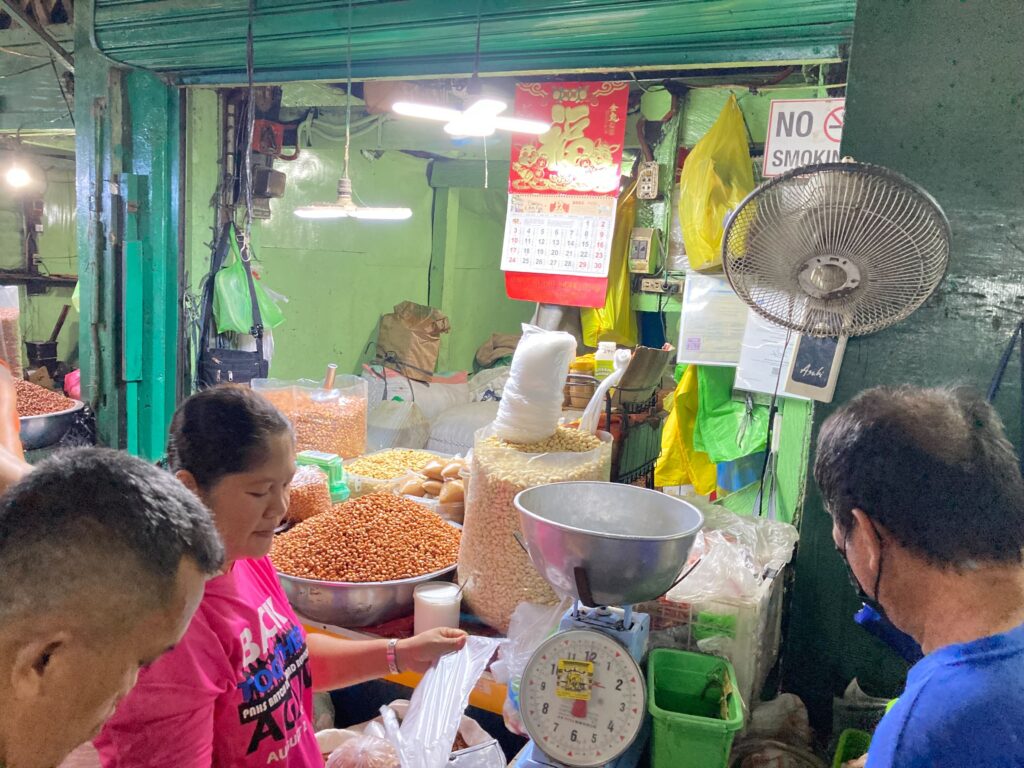
A peanut store in Carbon Public Market, primarily managed by Nathaniel Lamatao, 55. | CDN File photo by Niña Mae Oliverio
CEBU CITY, Philippines — The country’s inflation rose to 5.3 percent in August, according to the report of the Philippine Statistics Authority.
So how does the inflation, defined as the rate of increase in prices over a given period of time, affect local traders?
Ukay-ukay
For thrift clothes (ukay-ukay) seller, Joan Apit, 45, she said during pre-pandemic time, she could buy a bale of second-hand jeans weighing 100 kilos for P8,000-P9,000.
However, it had a drastic increase after that.
In February this year, a bale costs P11,000. It has risen up to P14,000 starting in June up to the present.
Each bale has more or less 200 jeans.
Second-hand jeans sold by Joan Apit, 45. | CDN photo by Niña Mae Oliverio
Her operating hours near Freedom Park used to be from 7 a.m. to 5 p.m. but since she has to exert more effort to boost her income, her operating hours now is from 7 a.m. to 10 p.m.
Extending her operating hours is one of her strategies besides doing “sales talks” to attract more customers.
“Naa sa’y ubang [customers] nga mawa na tungod sa [kamahal] sa mga palitunon,” she said. (There are also some customers who stop buying because of the high prices of goods.)
Peanut vendor
Meanwhile, Nathaniel Lamatao, 55, a peanut vendor for 16 years, said in an interview that despite the inflation, they still could not increase rates of their products.
Nathaniel Lamatao, 55 years old, peanut vendor. | CDN photo by Niña Mae Oliverio
“Dili nami mopasaka kay magpamahal man sa’g maayo wala na unya’y mopalit. Dili man ni parehas og bugas nga og momahal, paliton gihapon unya lung-agon para masulod sa atong tiyan. Pwede raman dili mokaon ang tawo og mani,” he said.
(We can’t increase our prices because that may stop people from buying. Unlike rice, which people would still buy even if it becomes more expensive, people can do without peanuts.)
He added that they have to just accept that their profit will be lower than before.
To adjust, they they added selling peanut butter and do online selling through Facebook for extra income.
The peanuts imported from India used to be at P4,400 per bag but it is now at P4,600. Each bag of peanuts weighs 50 kilograms.
Meanwhile, the skinless peanuts from China used to be P2,400 per box in pre-pandemic, but now it is now pegged at P2,975. Each box weighs 24 kilos.
Varieties of peanuts sold by Lamatao in their store in Carbon Public Market. | CDN photo by Niña Mae Oliverio
However, the local variation of peanut from Mindanao, called Imelda, has decreased in amount because it is harvest season there.
The Imelda peanut used to be at P5,750 per bag weighing 80 kilograms. As of September, it is priced at P4,900 per bag.
Onion vendor
Meanwhile, Rhea Salumoy, 26, who has been selling red onions and garlic for five years now in the Bagsakan in Carbon Public Market, feels relieved because onion prices have become “steady.”
Inflation seems to have not affected the selling of onions at this time.
Rhea Salumoy speaks about the situation of selling onions in the Bagsakan area in Carbon Public Market. CDN Digital photo | Niña Mae Oliverio
She could buy onions at P1,300 per bag weighing 10 kilos, which was P1,350 before. These onions are locally sourced from Mindoro and Pangasinan, she said.
Unlike ukay-ukay and peanut vendors, Salumoy allows her customers to loan her onions or else risk having it rot.
“Mo sugal ko’g pautang sa akong mga suki, basta lang maluwas ang mga baligya,” she stated.
(I will risk loaning to my loyal clients so that the products could be consumed.)
Has inflation also affected your business? Comment down below.
READ MORE:
MARCOS SONA 2023: Cebu business leaders hope inflation can be eased further